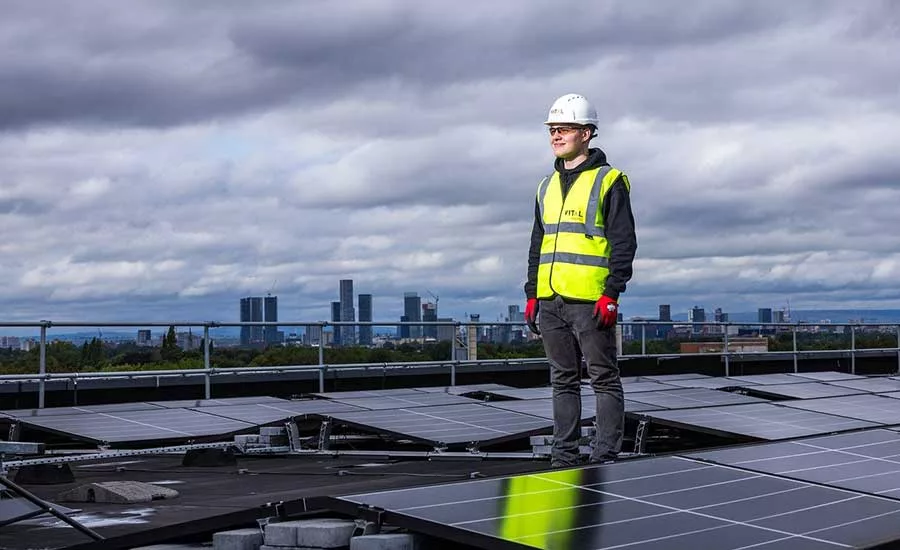Solar Special Section
New Report Shows Rooftop Solar More Efficient and Affordable
Solar panels are becoming more efficient, meaning the potential for roofing contractors to be successful solar installers is rising

Image by This_is_Engineering from Pixabay
Solar panels continue to grow in popularity among homeowners, and the latest data shows roofing contractors may have an easier time selling to customers thanks to lowered costs and more efficient technology.
In an August report titled “Tracking the Sun,” the Lawrence Berkley National Laboratory examined the pricing and design trends shaping distributed photovoltaic systems in the United States.
A total of 72 entities across 31 states contributed solar project data to the report, including state agencies, utilities and other organizations. Other data was pulled from PV building permit records and property data for customer segmentation.
This resulted in examining 3.7 million systems through 2023, or 78% of the U.S. market, and a sample size of 1.7 million systems for pricing.
Roof Coverage
The report specifically tracked photovoltaic roof coverage ratios, defined as “the percentage of roof space covered with PV, calculated here based on project-specific data for module and roof area.”
Roof-coverage ratios have remained relatively stable from 2010 to 2023. The report suggests this is due to increases in system power output caused by improved efficiencies in modules. When examining residential roof coverage, solar systems cover anywhere from 20% to 40% of the total roof area and are larger for multi-story homes versus single-story.
The sizes of non-residential roofs are much more varied, reflecting the broader range of building types and configurations found in the commercial and industrial space. As of 2023, the median is 23% of the roof space.
As previously mentioned, module efficiency is rising in both residential and non-residential systems, leading to more solar adoption. Denser installations result in reduced soft costs that scale with square footage.

Non-residential system sizes vary, ranging from 10 to 100 kilowatts with a median of 26 kilowatts.
Image by Roy Buri from Pixabay
System Sizes
The size of systems, which is measured by their generating capacity as opposed to their literal surface area, is increasing. Residential system sizes have risen steadily over the past 20 years due to declining costs and improved efficiencies in solar modules.
In 2023, the median size of residential systems was 7.4 kilowatts, with most systems ranging from 5 to 11 kilowatts. This is a massive increase compared to the average of 2.4 kilowatts in 2000.
On the non-residential side, systems sizes vary, ranging from 10 to 100 kilowatts (between the 20th and 80th percentiles) with a median of 26 kilowatts. According to the data, a sharp uptick toward larger systems took place in 2011-14, and in more recent years, it has been sliding back to smaller sizes.
As one might reasonably conclude, system sizes differ depending on which state they are found in. Residential systems in California, for example, are near the low end of the spectrum (6.6 kilowatts median), while most other states have a median above 7 kilowatts. The same goes for non-residential systems—Maine, for instance, has a significant share of larger systems thanks to initiatives like community solar projects.
What Customers Are Paying
Install prices for stand-alone PV systems have been falling steadily by $0.1 to $0.2 per watt annually. From 2022 to 2023, median install prices for residential systems fell about $0.1 per watt in real, inflation-adjusted terms, which is the same trajectory seen over the past decade.
Conversely, the median install prices for non-residential systems rose for the first time in 15 years by $0.1 to $0.2 per watt.
When examining the data sample, the report concludes that the falling real prices suggest that PV pricing has “thus far been less impacted by inflation compared to other consumer goods.” However, it warns that the effects on non-residential systems may not have been fully realized.
“Perhaps just as important, PV prices have risen more slowly than average U.S. retail electricity prices,” the report said.
The trend of decreasing install prices mirrors the abovementioned conclusions for systems paired with energy storage, with residential and large non-residential systems declining over the years. It’s worth noting that battery costs have been rising or remained relatively stagnant since at least 2019.
When examining pricing, the report did not factor in incentives provided to customers but did include upfront loan-financing fees passed through the installer.

On average, solar systems cover anywhere from 20% to 40% of the total roof area for residential projects, and are larger for multi-story homes versus single-story.
Image by Leopictures from Pixabay
Solar and Energy Storage
The report also examined the characteristics of PV installed alongside storage systems. From 2016 to 2023, it steadily rose, reaching 12% of the sample in 2023 for residential and 8% for non-residential. The data means contractors may wish to familiarize themselves with how to pair energy storage with the solar they offer.
That being the case, the report says most residential systems are paired with a single battery with 10 or 13.5 kilowatt-hours of storage, which provides an average duration of two to 2.7 hours.
“The market had been trending toward systems with larger amounts of storage capacity, potentially driven by backup power demand, but reversed course the past several years as the market became more geographically diversified,” the report states.
Non-residential storage is much more varied than residential storage, though the report shows that the majority have a relatively small amount of storage (a single 5-kilowatt or 10 to 13.5-kilowatt-hour battery). The main difference from residential storage is that it has longer duration periods, usually lasting for four or more hours.
Customer Observations
As of 2023, most residential systems were installed on detached single-family homes — a whopping 94% of them, versus the remaining 6% of apartments, mobile homes, townhouses, condos and small multi-family homes.
Roughly half of non-residential systems are installed on commercial buildings. Another one-third is installed on agricultural land, and the remainder by tax-exempt customers like schools and government facilities. For commercial systems, the largest customer base is retail, industrial, office and warehouse buildings.
Looking for a reprint of this article?
From high-res PDFs to custom plaques, order your copy today!








